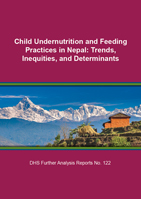There is no printed copy available to order.
Abstract:
In the changing governance structure, it is crucial to assess the impact of intensive investment in nutrition policy and programming on improved child nutritional outcome and feeding practices in the country and to guide the government in future policy and programming based on the evidence. This study uses data collected from the 2011 and 2016 Nepal Demographic and Health Surveys (DHS) to examine stunting and minimum acceptable diet as the key nutritional outcomes. We used descriptive analysis to see the change in distribution from 2011 to 2016, chi-square tests to detect association, and applied logistic regression with 2016 data using Stata version 15.1.
Nepal has reduced the prevalence of stunting and improved recommended complementary feeding practices, especially among the disadvantaged groups in the past 5 years. Yet, inequities exist across socioeconomic and sociogeographic areas. The child-intrinsic determinants of stunting are age and low weight of child. Among health and environmental determinants, access to the government health facility is associated with stunting while receiving all basic vaccines, handwashing with soap and water, and access to media protect against stunting. Socioeconomic determinants of stunting are province and household size, while wealth quintile and mother’s education are protective factors. For minimum acceptable diet (MAD), the only child-intrinsic determinant is age of child. Maternal determinants of MAD are mothers’ age and dietary diversity score. Health and environmental determinants of MAD are open defecation free (ODF); handwashing with soap and water; maternal, infant, and young child nutrition (MIYCN) counselling; and districts with nutrition-intensive programming. The socioeconomic determinants of MAD are province; residence; wealth quintile; caste/ethnicity; and mother’s education. Current determinants show there is a need to strengthen and scale up a tailored multisectoral approach with an integrated package of nutrition-specific and nutrition-sensitive interventions across sectors, namely health; water, sanitation, and hygiene (WASH); agriculture; and education.
 Child Undernutrition and Feeding Practices in Nepal: Trends, Inequities, and Determinants (PDF, 1640K)
Child Undernutrition and Feeding Practices in Nepal: Trends, Inequities, and Determinants (PDF, 1640K)
